
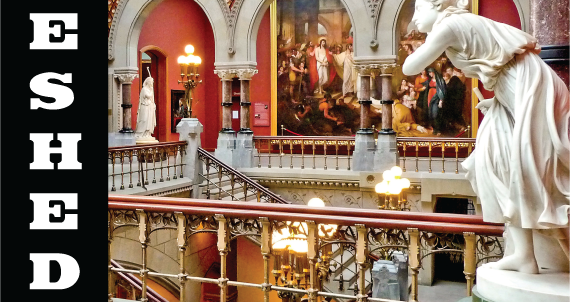 |
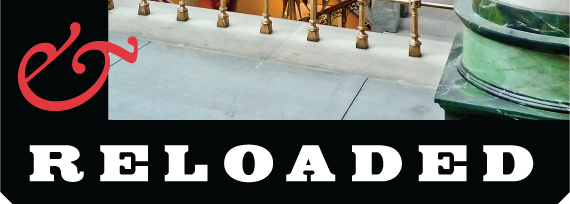 |
 |
by Anna O. Marley and Robert Cozzolino
|
How do you build upon one of the great collections of American art? And how can such familiar art appear transformed and enlivened? That was the challenge undertaken this summer by the Pennsylvania Academy of the Fine Arts (PAFA), where its curatorial team, which includes a trio of experts in eighteenth, nineteenth, twentieth, and twenty-first century art, collaborated to rethink the themes and layouts of the galleries through 1950. The result is dynamic new juxtapositions, thematic groupings, recent acquisitions, and resuscitated gems that will challenge and delight visitors. Collection strengths such as history painting, early American landscape, trompe l’oeil still-life, American impressionism, art by Robert Henri and The Eight, and Philadelphia modernism have been given special attention. Important works of Surrealism and early Abstract Expressionism pulled from PAFA’s holdings will likely surprise viewers familiar with our nineteenth-century holdings. After the initial rotation opens this September, periodic changes will place works such as Winslow Homer’s Fox Hunt and other treasures in new contexts, and curator of contemporary art, Julien Robson, will make use of the historical collection to reveal the links between past and present. Some highlights of the reinstallation are on the following pages.
|
|
 |
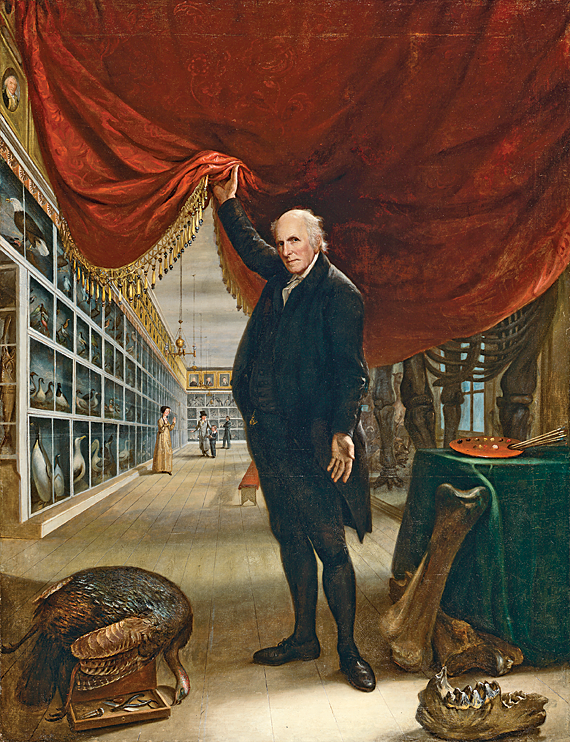 |
 |
Charles Willson Peale (1756–1833)
The Artist in His Museum, 1822
Oil on canvas, 103-3/4 x 79-7-8 inches
Gift of Mrs. Sarah Harrison (The Joseph Harrison, Jr. Collection) (1878.1.2)
|
This remarkable self-portrait—part advertisement, part philosophical manifesto—was executed by one of the founders of PAFA at the age of eighty-one. With more than a touch of showmanship, Peale raises a red velvet curtain to reveal the wonders of his collection, including his portraits of American worthies celebrating the leading men of the new century, then located in the long gallery on the second floor of Independence Hall. Peale’s Museum offered a cabinet of curiosities to instruct and entertain spectators, from a taxidermied wild turkey to the bones of a mastodon that Peale had exhumed and brought to Philadelphia. The Artist in His Museum stands as a triumphant artistic and historical accomplishment.
|
|
 |
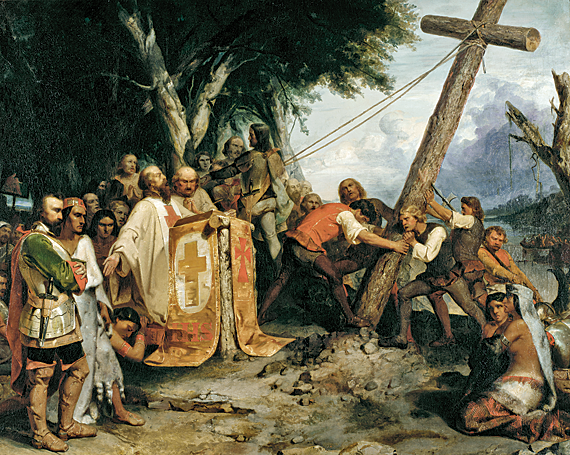 |
 |
Peter Frederick Rothermel (1812–1895)
De Soto Raising the Cross on the Banks of the Mississippi, 1851
Oil on canvas, 40 x 50 inches
Henry C. Gibson Fund and Mrs. Elliot R. Detchon (1987.31)
|
During a period of intense westward expansion and territorial conquest, including the Gold Rush of 1849, scenes of exploration became one of the most popular categories of history painting in America. In this painting Rothermel takes on the subject of the Spanish explorer Hernando De Soto’s expedition to the Mississippi River in 1541. Rothermel, a long-time faculty member of PAFA and one of America’s leading history painters, adapts an anecdote from American history to create a scene of “Manifest Destiny”—a period concept embodying the idea that the American empire had a Christian duty to make its way West, “civilizing” the entire continent.
|
|
 |
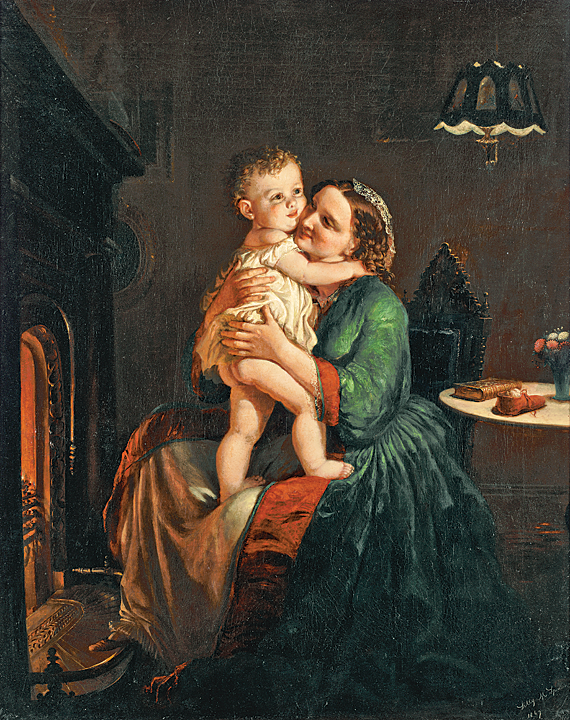 |
 |
Lilly Martin Spencer (1822–1902)
Mother and Child by the Hearth, 1867
Oil on canvas, 34-1/2 x 27-1/4 inches
Edna Andrade, Wyckoff, and Harriet B. Kravitz Funds (2010.2)
|
Lilly Martin Spencer, one of the earliest successful female artists working in a male-dominated profession, exhibited her work at PAFA in 1861 and 1862. At an exhibit staged by the American Art-Union in New York in 1852, her works brought higher prices than those of other contemporary genre painters George Caleb Bingham, Eastman Johnson, and William Sidney Mount. Painted two years after the close of the Civil War, this warm and intimate scene celebrates the connection between mother and child, and the safety and security of the Victorian home. This new acquisition is the first work by Spencer to enter the PAFA collection, and is part of the new installation on masters of nineteenth century genre painting.
|
|
 |
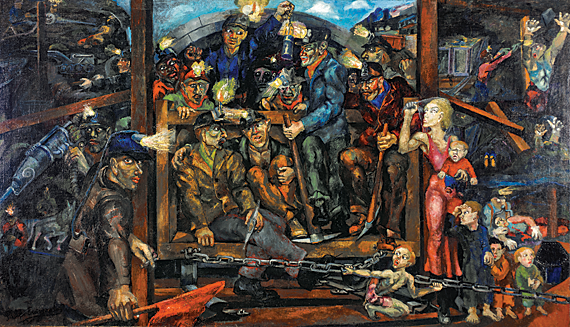 |
 |
Philip Evergood (1901–1973)
Mine Disaster, 1933
Oil on canvas, 40 x 70 inches
Edward H. Coates Fund (2010.1)
|
Long considered among the most significant easel-sized paintings of the 1930s aimed at political and humanist themes, Mine Disaster was an appeal for Evergood’s audiences to work for change in the world. Evergood painted it for the exhibition The World Crisis Expressed in Art on the Themes Hunger, Fascism, War, held under the auspices of the leftist John Reed Club in New York City in late 1933. The artist ambitiously crafted an empathetic secular altarpiece to workers for an audience he hoped would consider him a politically committed artist. In a letter written to Holger Cahill, Evergood identified the three parts of his triptych-like composition, from left to right: “Labor in Darkness,” “Rescue Squad,” and “Tragedy of Entombment.” Appropriate to the painting’s symbolic references, Evergood made martyrs of the miners who are forced to work in dangerous conditions in order to keep their families housed and fed.
|
|
 |
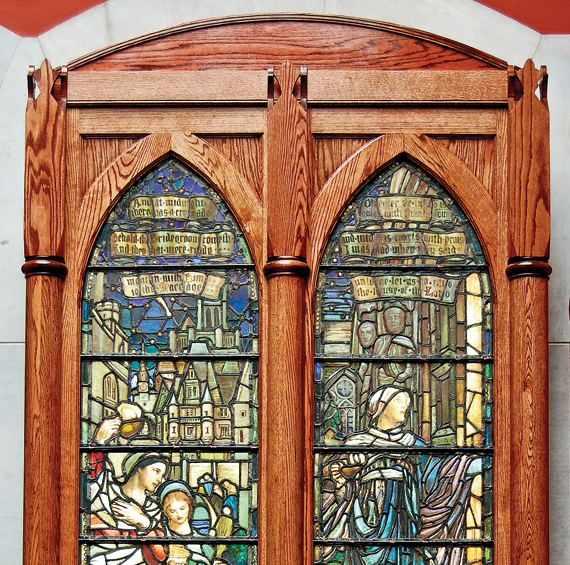 |
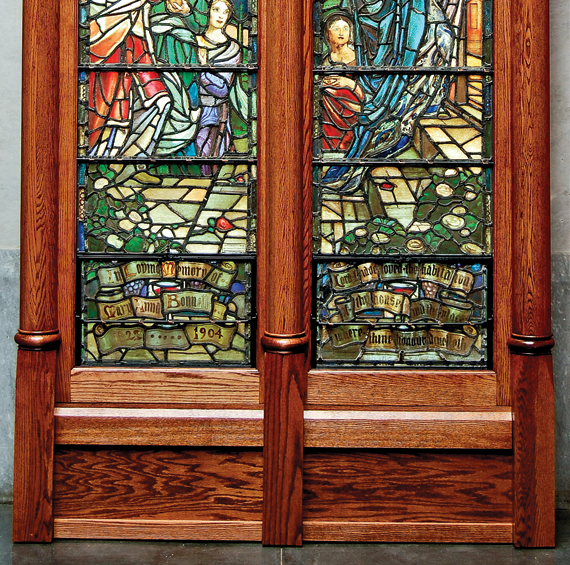 |
 |
Violet Oakley (1874–1961)
The Wise and Foolish Virgins, 1908–1909
Stained glass lancet windows, 100 x 23-1/4 inches in each window
John S. Phillips Fund (2009.2.1a&b)
|
The subject of Violet Oakley’s windows is the biblical parable of the wise and foolish virgins (Mathew 25:1–13). Oakley studied at PAFA and taught mural painting there from 1912 to 1917. Although she is best known as an illustrator, she was also a prominent mural painter and designer of stained glass. With its vivid colors and blending of medieval and modern traditions, the windows are one of Oakley’s finest creations. The windows and her original full-scale oil studies for the windows complement more than 2,000 of the artist’s paintings and drawings already in PAFA’s collection. These windows were made for St. Peter’s Church in nearby Germantown, which, like PAFA’s 1876 building, was designed by Frank Furness and George Hewitt.
|
|
 |
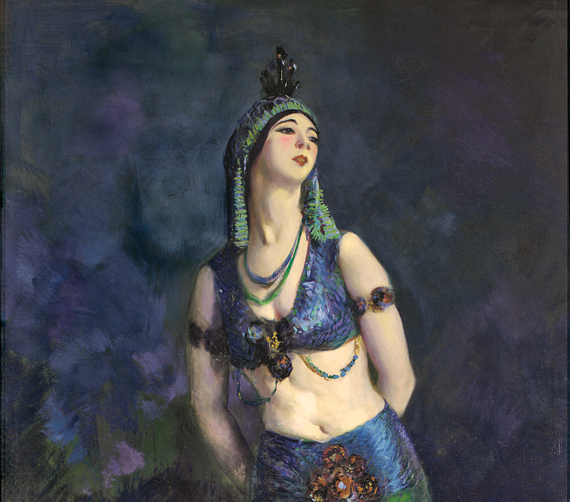 |
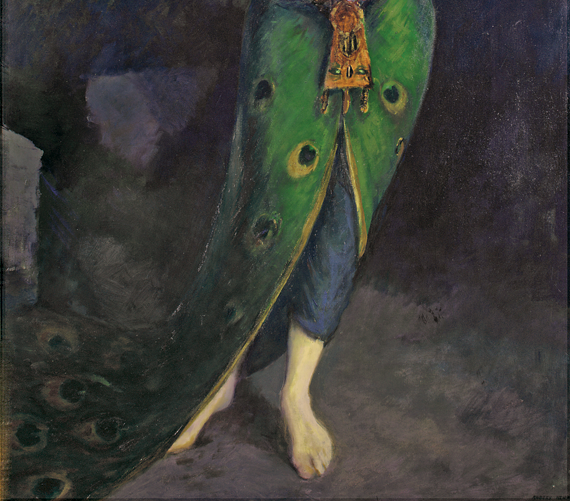 |
 |
Robert Henri (1865–1929)
Ruth St. Denis in the Peacock Dance, 1919
Oil on canvas, 85 x 49 inches
Gift of the Sameric Corporation in memory of Eric Shapiro (1976.1)
|
For many years Robert Henri’s seminal contributions to modernism were overlooked by art historians quick to credit Alfred Stieglitz and the artists he championed for a new language and spirit in American art. However, Henri’s philosophy, writings, and teaching helped prepare the environment for the radical art of his day. Henri had a great interest in the theater, evidenced by this striking full-length portrait of the celebrated modern dance pioneer Ruth St. Denis. Captivated by her legendary performance at New York’s Palace vaudeville house, Henri asked St. Denis to pose for what he called “a mighty propaganda.” Her choreography was frequently inspired by non-Western sources, and she based this role on an Indian legend of a woman who is turned into a peacock because of her extreme vanity. Henri painted St. Denis in her exotic costume of shimmering violet and green, her sinuous pose reflective of the dance’s graceful movement.
|
|
 |
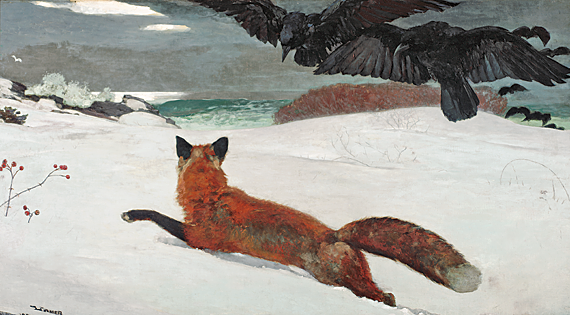 |
 |
Winslow Homer (1836–1910)
Fox Hunt, 1893
Oil on canvas, 38 x 68-1/2 inches
Joseph E. Temple Fund (1894.4)
|
After 1890, Homer frequently depicted subjects such as hunting and fishing in the Adirondacks and coastal Maine. Critics have interpreted these works as expressions of Darwin’s theory of natural selection, an idea of great currency in the late nineteenth century. In the Fox Hunt, Homer dramatized the brutal realities of winter in Maine by showing a fox’s desperate attempt to flee an ominous dark mass of half-starved crows. Homer’s carefully designed composition, indebted to his study of Japanese woodblock prints, supports the unfolding drama. This striking reversal of the natural order, in which the bird becomes the predator and the fox the prey, purchased by PAFA in 1893, became the first of Homer’s works to enter a public collection.
|
|
 |
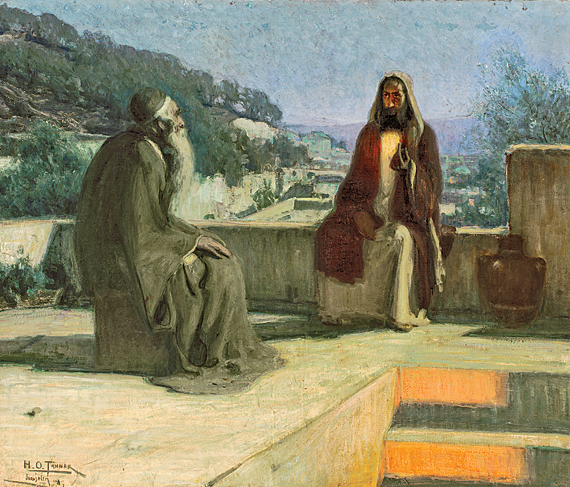 |
 |
Henry Ossawa Tanner (1859–1937)
Nicodemus, 1899
Oil on canvas, 33-11/16 x 39-1/2 inches
Joseph E. Temple Fund (1900.1)
|
The first African-American artist to achieve international prominence, Tanner was also one of the first African Americans to attend the Pennsylvania Academy of the Fine Arts. He achieved his greatest success at the Paris Salon with evocative biblical paintings marked by dramatic, even supernatural light effects. His father was a bishop in the African Methodist Episcopal Church, but Tanner’s own religious convictions instill these works with great sensitivity and a sense of quiet mystical intensity. Painted during his second visit to the Holy Land, Nicodemus will be featured in the exhibition, Henry O. Tanner: Modern Spirit, opening at PAFA January 27, 2012, and running until April 15, then traveling to the High Museum of Art in Atlanta, June 2 to September 2, 2012, and the Museum of Fine Arts, Houston, October 14, 2012 to January 6, 2013.
|
|
 |
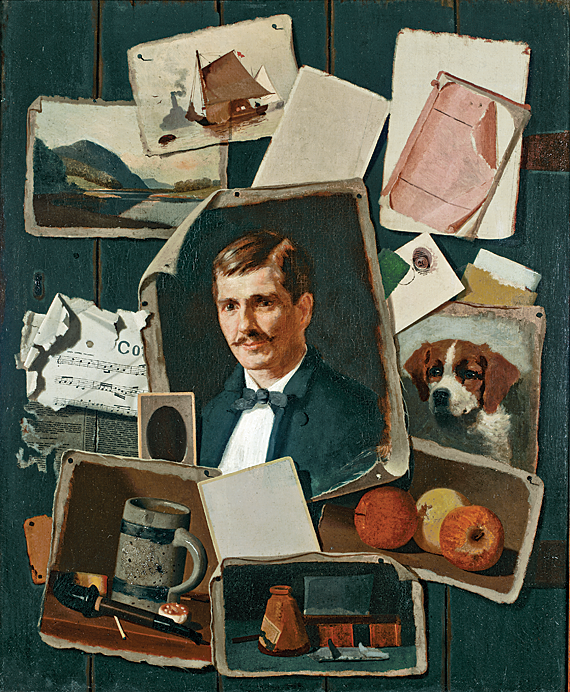 |
 |
John Frederick Peto (1854–1907)
Patch Self-Portrait with Small Pictures, ca. 1900
Oil on canvas, 29 x 24 inches
The Donald and Jean I. Stralem Collection
Bequest of Jean I. Stralem (2006.10.8)
|
A native Philadelphian, Peto studied at PAFA and became friends with PAFA alumnus and leading trompe l’oeil painter William Michael Harnett. Peto developed his own idiosyncratic mode of illusionistic painting, by softening edges, revealing rather than laboring to conceal brushstrokes, and combining unusual groupings of objects. He began his career as a portrait photographer and this may have heightened his awareness of illusionism and its many meanings. This work represents two of PAFA’s most important collection strengths in a single object as it is a significant self-portrait and innovative trompe l’oeil painting, of which there are many examples in the collection. Peto’s playful work makes his own visage a painted representation on canvas amidst a collection of canvases showing the range of genres he had mastered.
|
|
 |
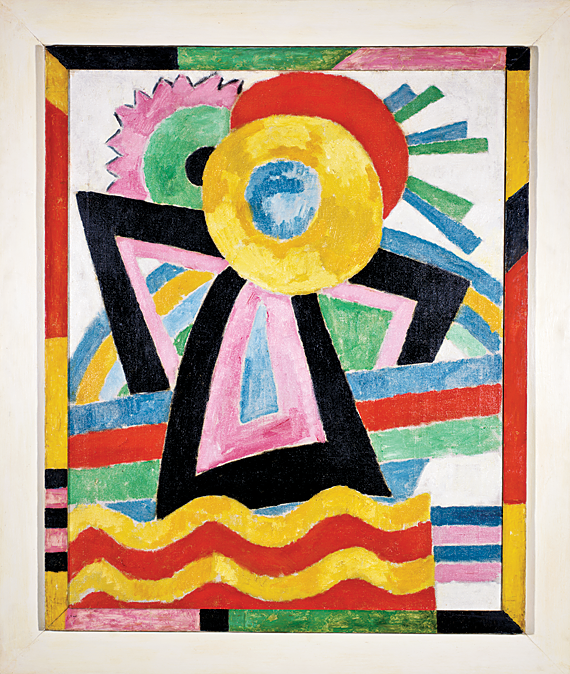 |
 |
Marsden Hartley (1877–1943)
Flower Abstraction, 1914
Oil on canvas, with painted wood frame, 42-3/8 x 34-7/8 inches
Gift of Meyer P. and Vivian O. Potamkin (2003.1.4)
|
One of PAFA’s key examples of early American modernism, Flower Abstraction is also a prime example of the paintings Hartley executed in Berlin between late winter of 1914 and the end of 1915. During this period, his well-known war motifs combined symbols from flags and military insignia, such as bars, medals and stripes, into flat decorative patterns. Flower Abstraction’s dancing, overlapping forms reflect many influences, including that of Robert Delaunay, whose work Hartley saw in Berlin, and Picasso’s contemporary Synthetic Cubism. In Flower Abstraction, Hartley moved beyond literal military motifs to a more daring and independent arrangement of nature forms, emotionally charged colors, and evocative relationships. The floral imagery with its high-keyed chroma and dynamic movement practically bursts out of the canvas, spilling across the colorful border onto Hartley’s painted frame.
|
|
 |
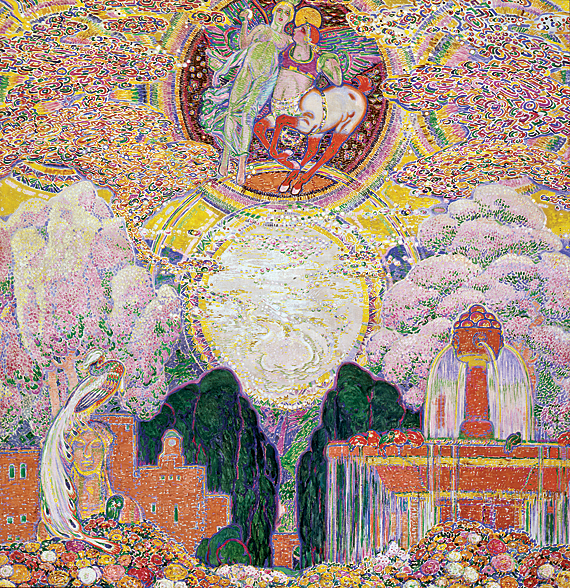 |
 |
Henry McCarter (1864–1942)
Symphony, by 1915
Oil on canvas, 103-3/4 x 100-3/4 inches
Gift of Mrs. Henry Clifford (1944.33)
|
Henry McCarter, an important PAFA teacher, was critical to Philadelphia’s modernist history. He studied at PAFA from 1879 to 1882 and then taught there from 1900 to 1942. In France he had apprenticed in the lithography workshop of Henri de Toulouse-Lautrec. Fascinated by myth and mysticism, he spent nine months at Trinity College in Dublin studying Irish folklore and the ninth-century illuminated Book of Kells. When he returned to America he became one of New York’s most sought-after magazine illustrators. McCarter experimented with subjective, expressive color, arbitrary light effects, and attempted to represent sound visually. He shared these concerns with other modernists in the United States and in Europe. His openness to new ideas influenced his students, who included Ivan Albright, Arthur B. Carles, and Charles Demuth. Symphony encompasses many aspects of McCarter’s artistic personality: beautiful draftsmanship, a love of the fantastic, experimental color palettes, and close study of illuminated manuscripts.
|
|
 |
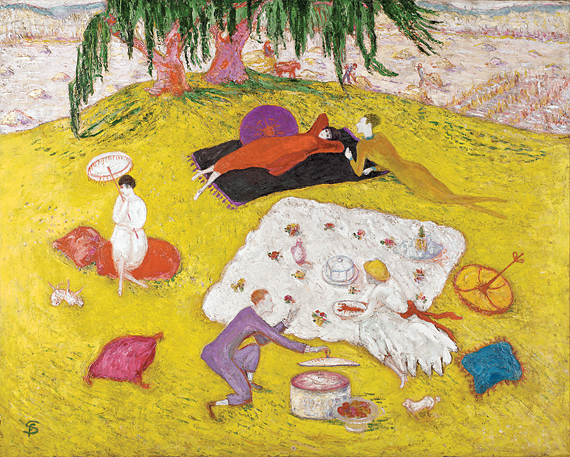 |
 |
Florine Stettheimer (1871–1944)
Picnic at Bedford Hills, 1918
Oil on canvas, 40-5/16 x 50-1/4 inches
Gift of Ettie Stettheimer (1950.21)
|
Florine Stettheimer studied at the Art Students League before obtaining further training in Munich and Paris during a fifteen-year European sojourn. Upon the outbreak of World War I, her family returned to New York and quickly came to dominate the city’s progressive art circles. The Stettheimer salon drew the major avant-garde figures in the twenties and thirties, including Marcel Duchamp and Elie Nadelman. In her own work, Stettheimer abandoned academic practices to cultivate a self-consciously “naïve” approach favoring outrageous color combinations and celebratory scenes, often including her friends and family. Picnic at Bedford Hills portrays the three Stettheimer sisters relaxing with Duchamp and Nadelman in a vibrant landscape while laborers plow the neighboring field. Painted toward the end of World War I, it can be seen as a pining for idyllic days before Europe was torn apart by conflict. The presence of Duchamp signals the critical artistic literary exchange between American and European that would continue through the 1920s.
|
|
 |
Founded in 1805, the Pennsylvania Academy of the Fine Arts (PAFA) is America’s first school of fine arts and museum. For more information, visit www.pafa.org.
|
|
 |
Anna O. Marley is curator of Historical American Art, and Robert Cozzolino is curator of Modern Art at the Pennsylvania Academy of the Fine Arts.
|
|
